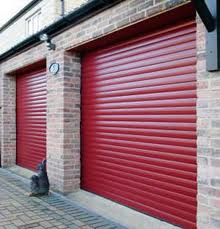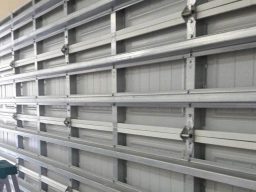It’s hardly surprising that the sales of wind-resistant garage doors have increased over the last decades. The catastrophic effects of hurricanes in the past have resulted in stricter building codes, giving a push to the wind-load garage door sales. Not that they were no building codes before, but the large number of deaths and the great destruction of hurricanes urged for more measures. The experts focused on testing wind impact, the technology improved, but today we still count tremendous losses after heavy storms. So, let’s see which factors affect the wind resistance of garage doors to see what steps we need to take.
Wind-resistant garage doors & their importance
Wind-resistant garage doors are tested to withstand the force of winds even during Category 5 hurricanes.
 During high winds and heavy storms, your overhead garage door is faced with two enemies.
During high winds and heavy storms, your overhead garage door is faced with two enemies.
- The pressure of the winds
- Flying debris
If this is not a hurricane garage door, the winds may create such a pressure as to blow it out. And when the wind enters the home, it will soon damage the rest of the structural elements (walls, roof, etc.). Debris become projectiles that may also cause great damage on the garage door, thus making it vulnerable and easy to blow out.
7+2 factors that may affect the garage door resistance
The garage doors must be strong to withstand impact and the force of winds. Which are the main factors that affect their resistance?
- Naturally, the number one factor that affects the wind resistance of the garage doors is their quality.
- The garage doors are more resistant when they are tested for their reaction to both negative and positive wind pressures. The negative pressure is that of pulling the door out of the structure, while the positive pressure is the load that pushes the door into the building. Such wind pressures are created based on the direction of the building in relation to its size.
 The wind-load garage doors must comply with the local building codes. There are international building codes (IBC) that address the safety concerns of buildings. And the truth is that wind-load garage doors bring peace of mind not only to the people who reside in hurricane-prone areas but also to those whose area experiences heavy storms too. All the same, each geographical area issues its own building codes based on the weather conditions of the location and must be followed to the letter.
The wind-load garage doors must comply with the local building codes. There are international building codes (IBC) that address the safety concerns of buildings. And the truth is that wind-load garage doors bring peace of mind not only to the people who reside in hurricane-prone areas but also to those whose area experiences heavy storms too. All the same, each geographical area issues its own building codes based on the weather conditions of the location and must be followed to the letter.- Although big buildings, large openings, and the direction of the home & of the garage door won’t affect your safety, they will determine what you get. Buildings may be tall or short, and hardly or particularly exposed to the elements (it depends on the space around the house, if it’s close to the ocean, etc.) Such factors must be taken into account before you choose a new garage door.
- It’s vital to remember that the effects of high winds on the structure are not determined as much by the wind speed as by the velocity the wind produces at a certain speed.
- The size and the strength of the garage door tracks and the brackets also matter. Wind load garage doors are reinforced, anyway. But you need to be sure the tracks and brackets are big and made of strong low-gauge steel.
- The garage door installation must be done with accuracy too. It’s not enough to get the best possible hurricane garage door – one that will meet the building codes in your location. It’s equally important to make certain it’s installed correctly. Otherwise, you lose the benefit of resistance.
In short, garage doors that are tested for their resistant to impact and wind pressure, and also integrate the right parts and framework to withstand the force will keep you safe. But don’t forget an element that often goes unnoticed once the hurricane-proof garage door is bought and installed: maintenance. Maintenance is required to keep the garage door in good shape and repairs are needed to ensure some problems that occur over the years are fixed and won’t make the garage door vulnerable.






